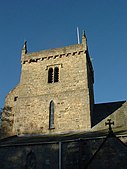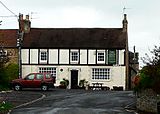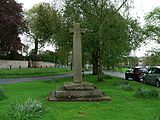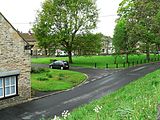Gainford: Difference between revisions
Created page with "{{Infobox town |name=Gainford |county=Durham |picture=Gainford Post Office, County Durham.jpg |picture caption=Gainford Post Office |os grid ref=NZ168166 |latitude=54.54508 |l..." |
|||
| Line 24: | Line 24: | ||
In the nineteenth century Gainford village had its own spa. Today its main features are an unspoilt village green, [[Gainford Hall]], a Jacobean hall, and a Georgian street called High Row. The village church of St Mary's, Gainford, stands on the site of an Anglo-Saxon monastery built by Bishop Ecgred of Lindisfarne in the early 9th century. | In the nineteenth century Gainford village had its own spa. Today its main features are an unspoilt village green, [[Gainford Hall]], a Jacobean hall, and a Georgian street called High Row. The village church of St Mary's, Gainford, stands on the site of an Anglo-Saxon monastery built by Bishop Ecgred of Lindisfarne in the early 9th century. | ||
In 1904 the family of a deceased Joseph Edleston owned a plot of land next to the churchyard of St Mary's in Gainford.<ref name=offeuds>Lloyd, Chris (January 5, 2005). "Echo Memories - Of feuds and fiefdoms in little Gainford", ''The Northern Echo'', Darlington. p. 8.</ref> His children asked to erect a monument in the churchyard in memory of Joseph's 41-year tenure at the church,<ref name=offeuds/> and while the church authorities refused permission, asserting that the churchyard was full, the family were told that they could donate their land to the church and then build a monument on part of it.<ref name=offeuds/> Feeling slighted, the family immediately set about building themselves a house on their land with a 40-foot column erected next to the churchyard so it towered over the trees.<ref name=offeuds/> The | In 1904 the family of a deceased Joseph Edleston owned a plot of land next to the churchyard of St Mary's in Gainford.<ref name=offeuds>Lloyd, Chris (January 5, 2005). "Echo Memories - Of feuds and fiefdoms in little Gainford", ''The Northern Echo'', Darlington. p. 8.</ref> His children asked to erect a monument in the churchyard in memory of Joseph's 41-year tenure at the church,<ref name=offeuds/> and while the church authorities refused permission, asserting that the churchyard was full, the family were told that they could donate their land to the church and then build a monument on part of it.<ref name=offeuds/> Feeling slighted, the family immediately set about building themselves a house on their land with a 40-foot column erected next to the churchyard so it towered over the trees.<ref name=offeuds/> The column was originally erected by Sir Hugh Smithson at Stanwick Park in [[Yorkshire]] to commemorate the Peace of Aix la Chapelle in 1748: it was acquired and re-erected by Robert Edleston in 1923.<ref>{{NHLE|1159714|Column east of Edleston House|grade=II}}</ref> The house has <small>MCMIV</small> (1904) over the front door.<ref name=offeuds/> | ||
==House styles== | ==House styles== | ||
Latest revision as of 19:32, 17 September 2024
| Gainford | |
| County Durham | |
|---|---|
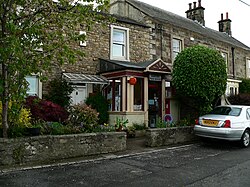 Gainford Post Office | |
| Location | |
| Grid reference: | NZ168166 |
| Location: | 54°32’42"N, 1°44’30"W |
| Data | |
| Population: | 1,241 (2011, with Denton) |
| Post town: | Darlington |
| Postcode: | DL2 |
| Local Government | |
| Council: | County Durham |
| Parliamentary constituency: |
Bishop Auckland |
Gainford or Gainford on Tees is a village on the north bank of the River Tees in County Durham, half-way between Barnard Castle and Darlington, near Winston.
The disused Gainford Railway Bridge crosses the Tees here.
History
In Anglo-Saxon times, Gainford was the centre of an estate that belonged to the Northumbrian Congregation of Cuthbert of Lindisfarne. Later, this area was occupied by Vikings. Archaeologists have found Viking sculptures at Gainford and several examples of these have been put on display in the Open Treasure exhibition at Durham Cathedral. Many sculptures found at Gainford show both Northumbrian and Viking influence.
In the nineteenth century Gainford village had its own spa. Today its main features are an unspoilt village green, Gainford Hall, a Jacobean hall, and a Georgian street called High Row. The village church of St Mary's, Gainford, stands on the site of an Anglo-Saxon monastery built by Bishop Ecgred of Lindisfarne in the early 9th century.
In 1904 the family of a deceased Joseph Edleston owned a plot of land next to the churchyard of St Mary's in Gainford.[1] His children asked to erect a monument in the churchyard in memory of Joseph's 41-year tenure at the church,[1] and while the church authorities refused permission, asserting that the churchyard was full, the family were told that they could donate their land to the church and then build a monument on part of it.[1] Feeling slighted, the family immediately set about building themselves a house on their land with a 40-foot column erected next to the churchyard so it towered over the trees.[1] The column was originally erected by Sir Hugh Smithson at Stanwick Park in Yorkshire to commemorate the Peace of Aix la Chapelle in 1748: it was acquired and re-erected by Robert Edleston in 1923.[2] The house has MCMIV (1904) over the front door.[1]
House styles
The houses around the green are mostly Georgian with some rubble-built houses on the north and south sides of the green. When they were built, the rubble-built houses would have been rendered, but the present fashion is to reveal the stonework with the rendering removed. Roofs are mostly red pantiles, and tend to be finished with a line of split-stone along the eaves. Some of the larger buildings have blue slate roofs, the slate probably brought by the railway. The older cottages in the village have steep pitched roofs in a style that suggests earlier heather thatching.[3]
Village cross
Torwards the western end of the village green stands a stone cross on a square base. The base is thought to be mediæval in origin, but the cross itself is Victorian. It is dated 1897 and commemorates Queen Victoria's Diamond Jubilee. The Cross was made by Isaac Charge and Son, of Gainford. The cross has a slightly battered shaft and Saxon-type head. There is an inscription on the west face of the shaft which states: 'In thankful commemoration of the sixtieth anniversary of the accession of Queen Victoria on June 20th 1897. This cross was re-erected and trees planted on the green by the inhabitants of Gainford'.[4]
Pictures
| ("Wikimedia Commons" has material about Gainford) |
Outside links
References
- ↑ 1.0 1.1 1.2 1.3 1.4 Lloyd, Chris (January 5, 2005). "Echo Memories - Of feuds and fiefdoms in little Gainford", The Northern Echo, Darlington. p. 8.
- ↑ National Heritage List 1159714: Column east of Edleston House (Grade II listing)
- ↑ Durham County Council: Gainford Conservation Appraisal - December 2013 Template:Webarchive
- ↑ National Heritage List 1159562: Village Cross (Grade II listing)

